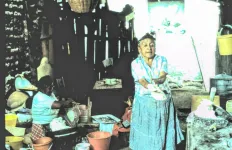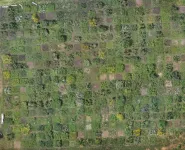(Press-News.org) COLUMBUS, Ohio - On the outskirts of some small Indigenous communities in the Mexican state of Oaxaca, a few volunteer guards keep watch along roads blocked by makeshift barricades of chains, stones and wood.
The invader they are trying to stop is COVID-19.
For many of Mexico's Indigenous people, poor and ignored by state and federal governments, the fight against the COVID-19 pandemic is one that rests primarily with themselves, said Jeffrey Cohen, a professor of anthropology at The Ohio State University.
That means they must take steps like limiting access to their villages.
"Most of these communities only have one road in and out," Cohen said. "So these guards, called topiles, block that road so that outsiders with the virus won't get in - and residents won't go to a nearby city and potentially bring the virus back."
Cohen has spent years in the central valleys of Oaxaca conducting anthropological research among the Zapotec people.
In the journal Global Public Health, Cohen recently co-authored an article about how the Indigenous people in Oaxaca are coping with the pandemic. His co-author is Nydia Delhi Mata- Sánchez, his former student and now the rector of the Universidad Tecnológica de los Valles Centrales de Oaxaca.
Oaxaca, in southern Mexico, is one of the country's most ethnically diverse states and home to many indigenous minority groups, including the Zapotec. It is also one of poorest states in the country. The Mexican government estimates that nearly 70 percent of the nation's Indigenous population lives in poverty.
Most of the Indigenous communities in Oaxaca are small and isolated, which has kept them comparatively less exposed to the coronavirus than the rest of Mexico.
About two-thirds of the approximately 500 indigenous and rural communities in Oaxaca had no cases of COVID-19 when Cohen and Mata-Sanchez were doing research for this paper in the early months of the pandemic. Now about one-third still have no cases, Cohen said.
But as the virus has seeped into their villages, the Zapotec and other Indigenous people are finding ways to cope with the pandemic. One is through setting territorial boundaries like the roadblocks.
Also, village leaders are promoting social distancing and the use of masks. While these measures have become a political issue in many parts of Mexico, as they have in the United States, that's not a problem among most Indigenous communities.
"One of the strengths of these local leaders is that they have a more traditional form of leadership that isn't based on political affiliations," Cohen said.
"The village leaders are generally respected by the people and they are listened to when they promote health measures like wearing a mask and social distancing."
In addition, villagers are rethinking their eating habits and turning to traditional food sources that had lost popularity in recent years as residents traveled to food markets in larger towns for more modern fare.
For example, villagers are collecting wild honey, as they used to do more often in earlier times. And many have returned to eating "chapulines," grasshoppers harvested from the fields and quickly toasted over a fire.
"It is a protein-rich alternative to expensive, store-bought meats that are no longer available locally," Cohen said.
"These are the kinds of foods that never went away completely, but were less popular, especially among younger people who thought of these as things their grandparents ate."
But what may be the most important key to how the Zapotec are coping with the pandemic is the strengthening of the tradition of reciprocity among their peoples.
"It is a more formal arrangement than just helping neighbors as we see in America. It is so important that it has its own name - in the area where I have done research it is called guelaguetza," Cohen said.
When people have become sick with COVID or other diseases, community members will take care of their food crops, and share their water and food. No one is left to fend for themselves, he said.
Although the Zapotec and other Indigenous people in Mexico are fighting the pandemic as best they can, they need more government support.
"There is still so little response at the state and federal level to Indigenous concerns," he said. Many of these needs preceded COVID-19, but the pandemic has exacerbated the issues.
The most pressing concern for most communities is access to clean water, according to Cohen. The lack of potable water increases the risk of intestinal problems like cholera, among other health conditions, which will intensify the effects of COVID-19.
In addition, many Indigenous people must travel outside their villages for education, work and health care, which is difficult and dangerous during the pandemic.
"Many people were hurting before COVID-19 and the pandemic is only making things worse," Cohen said. "The Zapotec's best bet, they know, is still themselves."
INFORMATION:
Contact: Jeffrey Cohen, Cohen.319@osu.edu
Written by Jeff Grabmeier, 614-292-8457; Grabmeier.1@osu.edu
peer review/experimental study/animals/cells
Researchers from Uppsala University show in a new study that inhibition of the protein EZH2 can reduce the growth of cancer cells in the blood cancer multiple myeloma. The reduction is caused by changes in the cancer cells' metabolism. These changes can be used as markers to discriminate whether a patient would respond to treatment by EZH2 inhibition. The study has been published in the journal Cell Death & Disease.
Multiple myeloma is a type of blood cancer where immune cells grow in an uncontrolled way in the bone marrow. The disease is very difficult to treat and is still considered incurable, and thus it is urgent to identify new therapeutic targets in the cancer cells.
The research group behind ...
TROY, N.Y. -- An antioxidant found in green tea may increase levels of p53, a natural anti-cancer protein, known as the "guardian of the genome" for its ability to repair DNA damage or destroy cancerous cells. Published today in Nature Communications, a study of the direct interaction between p53 and the green tea compound, epigallocatechin gallate (EGCG), points to a new target for cancer drug discovery.
"Both p53 and EGCG molecules are extremely interesting. Mutations in p53 are found in over 50% of human cancer, while EGCG is the major anti-oxidant in green tea, a popular beverage worldwide," said END ...
DURHAM, N.C. -- Humans aren't the only mammals that form long-term bonds with a single, special mate -- some bats, wolves, beavers, foxes and other animals do, too. But new research suggests the brain circuitry that makes love last in some species may not be the same in others.
The study, appearing Feb. 12 in the journal Scientific Reports, compares monogamous and promiscuous species within a closely related group of lemurs, distant primate cousins of humans from the island Madagascar.
Red-bellied lemurs and mongoose lemurs are among the few species in the lemur family tree in which male-female partners stick together year after year, working together to raise their young and defend their territory.
Once bonded, pairs spend much of their waking hours grooming ...
Every year around 20 Australian children die from the incurable brain tumour, Diffuse Intrinsic Pontine Glioma (DIPG). The average age of diagnosis for DIPG is just seven years. There are no effective treatments, and almost all children die from the disease, usually within one year of diagnosis.
A paper published today 12 Feb 2021 in the prestigious journal, Nature Communications, reveals a potential revolutionary drug combination that - in animal studies and in world first 3D models of the tumour - is "spectacularly effective in eradicating the cancer cells," according to lead researcher and paediatric oncologist Associate Professor David Ziegler, from the Children's Cancer Institute and Sydney Children's Hospital.
In ...
Children treated for cancer with approaches such as chemotherapy can develop therapy-related myeloid neoplasms (a second type of cancer) with a dismal prognosis. Scientists at St. Jude Children's Research Hospital have characterized the genomic abnormalities of 84 such myeloid neoplasms, with potential implications for early interventions to stop the disease. A paper detailing the work was published today in Nature Communications.
The somatic (cancer) and germline (inherited) genomic alterations that drive therapy-related myeloid neoplasms in children have not been comprehensively ...
(Friday, February 12, 2021 - Toronto) -- Inhibiting a key enzyme that controls a large network of proteins important in cell division and growth paves the way for a new class of drugs that could stop glioblastoma, a deadly brain cancer, from growing.
Researchers at Princess Margaret Cancer Centre, the Hospital for Sick Children (SickKids) and University of Toronto, showed that chemically inhibiting the enzyme PRMT5 can suppress the growth of glioblastoma cells.
The inhibition of PRMT5 led to cell senescence, similar to what happens to cells during aging when cells lose the ability to divide and grow. Cellular senescence can also be a powerful tumour suppression mechanism, stopping ...
Space: the final frontier. What's stopping us from exploring it? Well, lots of things, but one of the major issues is space radiation, and the effects it can have on astronaut health during long voyages. A new review in the open-access journal END ...
Research over the last 20 years has shown that atherosclerosis is a chronic inflammatory condition of the arterial blood vessel wall. Soluble mediators such as cytokines and chemokines are pivotal players in this disease, promoting vascular inflammation. However, the development of anti-inflammatory therapeutics directed against such mediators that could prevent atherosclerosis has proven difficult, despite promising clinical studies in the recent past.
Previous anti-inflammatory therapeutic strategies to prevent atherosclerosis, heart attacks, strokes, rheumatoid arthritis and other inflammatory diseases have mainly been based ...
Remote sensing technology has become a vital tool for scientists over the past several decades for monitoring changes in land use, ice cover, and vegetation across the globe. Satellite imagery, however, is typically available at only coarse resolutions, allowing only for the analysis of broad trends over large areas. Remote-controlled drones are an increasingly affordable alternative for researchers working at finer scales in ecology and agriculture, but the laser-based technology used to estimate plant productivity and biomass, such as light detection and ranging (LiDAR), remain prohibitively expensive.
In research presented in a recently published issue of Applications in Plant Sciences, researchers ...
New research has shown that results of blood tests routinely performed by GPs everywhere contain a hidden fingerprint that can identify people silently developing potentially fatal liver cirrhosis.
The researchers have developed an algorithm to detect this fingerprint that could be freely installed on any clinical computer, making this a low-cost way for GPs to carry out large scale screening using patient data they already hold.
Liver cirrhosis is the second leading disease causing premature death in working-age people (after heart disease). It develops silently ...





